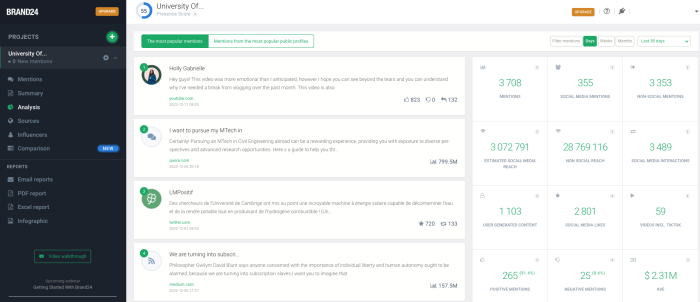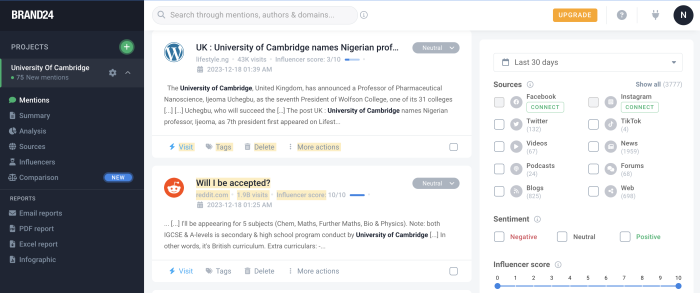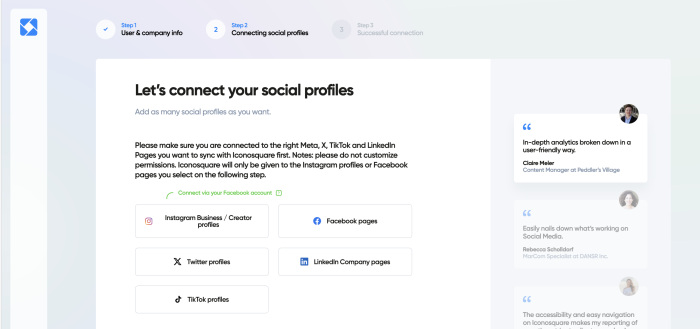As social media evolves, how students, parents, and the community communicate and share feedback about educational experiences is also changing. This year, for example, we will see a growing reliance on social media platforms for customer service and as valuable sources for school and program reviews. Schools must adapt their social listening strategies to these new dynamics.
Although social media listening is not a new practice, this trend underscores the importance of active social listening to gain insights and respond effectively to audience demands. Many schools may already be familiar with social monitoring, but it is essential to understand their differences.
So, what is the difference between social media monitoring and social listening? Social media monitoring tracks specific mentions and feedback, while social listening analyzes broader trends and sentiments behind these interactions for strategic insights. Understanding this distinction is crucial as schools navigate the evolving landscape of social media communication. If your school hasn’t reviewed its social media listening practices in a while, this is your call to action! Continue reading to discover tips for creating an effective social media listening strategy, a crucial component in today’s digital communication toolkit.
What is Social Media Listening? The Art of Listening Online
Social media listening refers to monitoring digital conversations to understand what is being said about your school across different social media platforms. This process involves tracking social networks, forums, blogs, and other online spaces for mentions and discussions related to specific keywords, phrases, industries, or brands. This approach is essential for schools seeking insights about their audience’s feelings, opinions, and needs. By analyzing this information, they can tailor their strategies, products, and services to align with their audience’s preferences and trends in the broader market.
For example, using tools like Brand 24, schools can monitor specific keywords used by their community members or by competitors to understand what the online conversation around those words is and how it influences perceptions, trends, and overall sentiment towards their institution.

Source: Brand24
Do you need some help managing and monitoring your social media platforms? At HEM, we can help you keep your accounts up to date while providing valuable insights and strategies to enhance your online presence and engagement. Get in touch with us today!
If this practice is new to you, what are the benefits of social media listening? The benefits of social listening are manifold. From refining marketing strategies and understanding audience needs to improving customer services, it drives informed decision-making and growth. Additionally, educational institutions can use social listening to contribute to student recruitment and retention efforts. For instance, by engaging in social listening, schools can better understand what potential students are discussing and showing interest in. This valuable insight allows them to tailor their recruitment messaging effectively, aligning it with the interests of prospective students, thereby attracting a more engaged and suitable student body.
Social listening also offers critical data that can significantly improve a school’s digital marketing strategies. By identifying the types of content that resonate most with their audience, schools can refine their online presence, crafting marketing campaigns that are more impactful and engaging, ultimately leading to a more substantial digital footprint and broader outreach.
Lastly, one of the most significant advantages of social listening lies in its ability to inform the adaptation and innovation of academic programs and support services. The feedback and discussions captured through social media can reveal areas requiring enhancement or innovation. Schools can leverage this information to modify their academic offerings and student services, ensuring they remain not only relevant but also responsive to the current needs of students and evolving industry trends. This proactive approach to adapting based on real-time feedback positions educational institutions as forward-thinking and student-centric, which is crucial in today’s competitive educational landscape.
Tips to Get Your Social Media Listening Strategy Ready
There are several steps that schools can take to create an effective social media listening strategy:

1. Define your goals: Clearly articulate your goals with your social media listening campaigns, such as improving brand perception or increasing student engagement. Setting goals is essential, as your goals will determine the metrics and strategies you will be using.
2. Determine which tools and platforms you will use: Select appropriate social media listening tools and platforms (Facebook, Instagram, TikTok, LinkedIn, YouTube) that best suit your goals and audience. You can limit your listening to platforms you are already engaged, or you can extend your listening to other platforms to get a broader picture of the conversation. If you are new to social listening, you can work with tools like Digimind, which allows you to choose your goals to tailor your analysis.

Source: Digimind
3. Identify keywords and hashtags relevant to your school: Determine relevant keywords and hashtags related to your school, programs, and community topics that your audience could use to talk about your school.
4. Choose which metrics you would like to track: Choose metrics that align with your goals, like sentiment analysis, engagement rates, or mention volume. For example, if you aim to understand brand awareness, you should focus on metrics like brand mentions, share of voice, and hashtag usage.
5. Analyze your results: Regularly review the data gathered to understand trends, sentiments, and the effectiveness of your content.
6. Apply your findings: Use your insights to improve your overall inbound and outbound marketing strategies.
Now that you understand how a social media listening strategy works, you might be eager to learn about actual social listening examples. Suppose your school is, for instance, trying to gauge overall sentiment and reputation among students, parents, and the broader community. In that case, you can use a listening tool to follow and track mentions of your name or associated hashtags on social media, as we did as an example below with the keyword “University of Cambridge.”

Source: Brand24
Pro tip: Tools like Brand 24 will allow you to select the sources you want to check (blogs, social media, forums, news articles, podcasts, etc.). Make sure to think about this before you start your analysis.
Social Media Listening Best Practices to Follow
Social media listening is not just about gathering data but actively engaging with your community. One of the most essential social listening best practices is to participate in conversations related to your school actively. For instance, if you notice someone talking about your institution or providing feedback, engaging with a like or a thoughtful comment can show your school’s involvement and responsiveness, as seen in the example below.
This interaction not only boosts engagement but also fosters a positive community image. In addition, social listening is an invaluable tool for providing customer service. By promptly addressing queries and guiding prospective students through their application journey, your school can enhance its support system and student experience.

Source: University of Waterloo
Another critical aspect is identifying opportunities through audience analysis. What are students, parents, and staff saying about your school? Use this feedback to refine your school’s offerings or address specific community needs. This proactive approach can significantly improve your educational and extracurricular programs. Additionally, monitoring shouldn’t be limited to one platform. With the diverse social media channels, monitoring multiple platforms is crucial to get a comprehensive view of the conversation surrounding your school. This ensures you’re not missing out on essential discussions and feedback.
Staying on top of the latest trends in education and social media is also essential. However, it’s important to discern which trends align with your school’s values and mission. Not every social media fad will be appropriate for your school’s image and goals. Lastly, addressing negative feedback is vital. Engage with any negative comments tactfully and constructively. This helps maintain a positive reputation and demonstrates your commitment to continuous improvement and open dialogue. These best practices in social media listening enable schools to build stronger relationships with their community, adapt to changing needs, and maintain a dynamic and positive online presence.
What Are the Limitations of Social Media Listening?
Social media listening faces limitations like incomplete data coverage, as not all brand-related conversations are online or public, and the potential misinterpretation of sentiments due to language nuances and sarcasm. Furthermore, there’s a time lag between real-time events and data availability, which might delay responses. However, proper training and sophisticated tools can effectively address these challenges.
Training can equip your team with the skills to interpret complex language cues and sarcasm better. At the same time, advanced listening tools, such as the ones we will present in the following section, can minimize data gaps and reduce response time lags, ensuring a more accurate and timely analysis of social media conversations.
Choosing the Right Platforms and Tools for Effective Social Listening
When selecting the right tools and platforms for social listening, several key factors must be taken into account to ensure they align with your needs and objectives:
Platforms:
Identifying which social media platforms your target audience uses most frequently is crucial. Different demographics and communities favour platforms (like Twitter, Facebook, Instagram, LinkedIn, or niche forums). Choose platforms where your audience is most active and where conversations about your brand or industry are happening.
Tool Features:
The features offered by a social listening tool are pivotal. Look for tools that provide functionalities that align with your specific goals. For instance, if you’re keen on understanding public sentiment about your brand, opt for a tool with robust sentiment analysis capabilities. Or, if keeping abreast of emerging trends is crucial, choose one that excels in trend tracking.
Integration:
It’s important to consider how well a social listening tool integrates with your existing technological infrastructure, including your current social media platforms and CRM systems. Seamless integration ensures smooth data flow and simplifies processes, enhancing overall efficiency.
Usability and Customer Support:
The user-friendliness of a tool is crucial, especially if multiple team members will use it. Tools that are intuitive and easy to navigate can save time and reduce the learning curve.
Budget Considerations:
Finally, the cost of the tool is a significant factor. It’s essential to evaluate the pricing to your budget constraints. Consider the initial cost and ongoing fees, such as subscriptions or updates. Weigh the tool’s benefits against its cost to ensure it delivers value for money and fits within your financial parameters.
While a lot of the listening tools in the market are paid, you might be able to find free social media listening tools or at least free trials. For instance, Brand24, Iconosquare, and Fedica offer completely free access to their tools for a limited time. Other tools might offer trials, but you need to schedule a meeting with their sales associates to get access.
Regardless of what you do, free trials allow you to get a taste before committing to a subscription or purchase. Utilizing these trials can help you evaluate the tool’s features, ease of use, and compatibility with your needs, ensuring you make an informed decision that aligns with your social listening objectives and budget constraints.

Source: Iconosquare
Other tools you might want to consider are:
- Hootsuite: Offers comprehensive monitoring across multiple social media platforms and allows for scheduling posts and analyzing social media traffic.
- Sprout Social: Provides in-depth analytics, social listening, and engagement tools, making it helpful in understanding audience trends and interactions.
- Mention: Tracks mentions across the web and social media, offering real-time monitoring and insights into audience sentiments.
Navigating the landscape of social media listening can be significantly easier if you have the right tools. Consider each of these tools, and select the one that seems the most appropriate to reach your school’s objectives.







